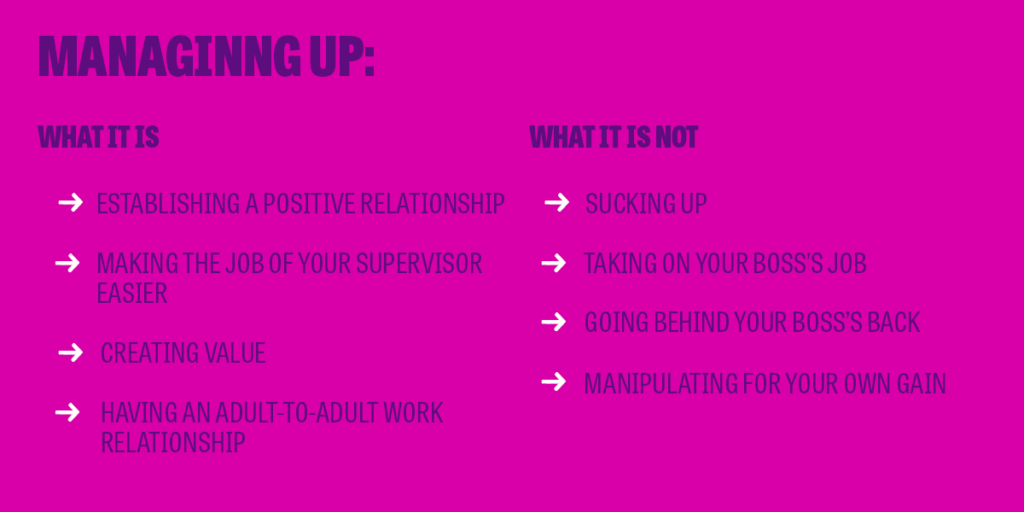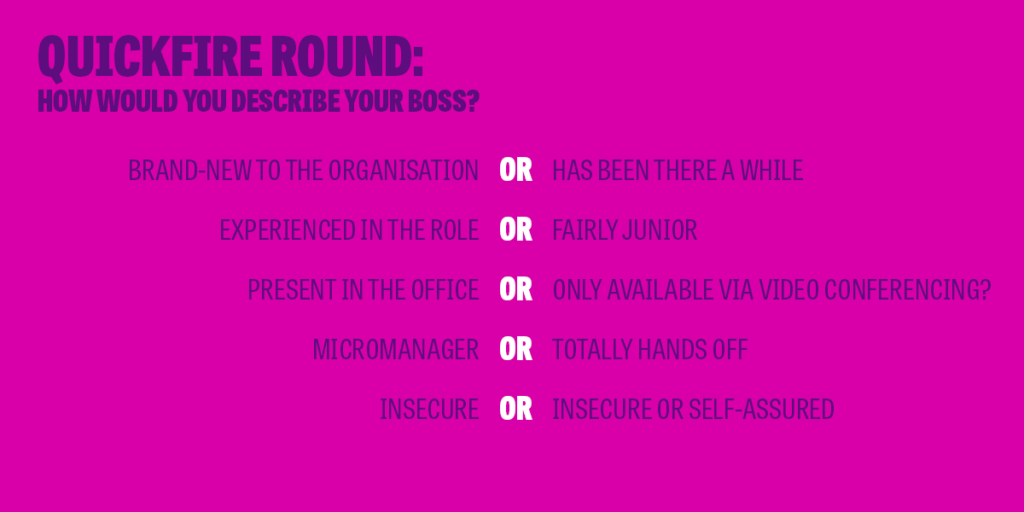Unlocking your potential by managing your boss
When it comes to boosting your job satisfaction and increasing your performance, your manager can be your best ally. But managers can be a mixed bag. Throughout our careers, most of us have had some great ones, some good ones, some average ones, and maybe even a bad one or two. What happens when your manager doesn’t have the time or the resources to help you achieve your goals? Is it just a case of sticking it out or leaving your job? “Absolutely not,” says Catherine Wilson, Senior Consultant at Let’s Talk Talent. “Your relationship with your boss is as much your responsibility as it is theirs, and that means there is plenty you can do to turn it into a positive one and to take control of your professional development.”
It’s often been said that people don’t leave organisations, they leave bad managers, and having a healthy, positive relationship with your manager is essential. While this is not always possible for many reasons, it’s important to remember that nobody gets up in the morning trying to be a bad boss. There are many reasons why a manager may be struggling to support you adequately, and there are several ways to manoeuvre the situation. Here’s a practical approach to empowering yourself to get what you need from your boss.
What is managing up?
Managing up is essentially when a direct report, through a positive relationship, is able to make the job of their line manager easier. In short, it’s all about creating value for your boss. In turn, they will guide you to be the best employee possible. We spend most of our lives at work, and the dynamic with our manager is an important one: it falls to both parties to maintain and improve it.
It’s worth noting that managing up often has a negative connotation. Many see it as undermining, going around their boss or even worse, going behind their boss’s back. Others see it as taking on their manager’s job, when they are busy enough as it is. At Let’s Talk Talent, we disagree. Just like any other relationship, the one with your manager has to be one between two equals, and based on mutual respect. Or as we say in transactional analysis, from one adult to another. To get to this point, both parties have to understand what the other wants and needs.

The benefits of managing up
If you know us, you’ll know that we believe employees can, and should, take charge of their own progression. As per the 70-20-10 ratio, 70% of an individual’s development sits squarely on their shoulders, while the remaining 30% is the support they need from their manager and the organisation. Managing up is a great example of taking accountability for your own performance.
For more information on the 70-20-10 ratio and its role in learning and development, read our blog article.
Improving the relationship between you and your boss can only yield plenty of benefits, including:
- Goal achievement. Through increased support, you are more likely to achieve your yearly objectives and contribute to the organisation in a meaningful way.
- Opportunities for career progression and professional development. Discussing your career goals with your manager could uncover new opportunities that could benefit your career.
- Increased accountability and confidence. When we take control of the situation and relationship, we empower ourselves and build confidence.
- Improved productivity and performance. An increase in understanding between you and your manager is likely to lead to better performance, as your objectives will be more aligned and the lines of communication will be open.
- Empowerment and motivation. Working on improving your relationship with your manager means you’ll have more control over your professional situation than you initially thought, which can be a powerful and empowering revelation.

A practical approach to managing up at work
Step 1: Understanding your manager
Managing up starts before you’ve even set foot in your manager’s office. Like any well-structured project, it begins with an audit phase to fully understand the challenge at hand. Ask yourself: “How would I describe my boss? What kind of manager are they?” Are they new to the job and slightly insecure? Do they fear making big decisions as there is a culture of blame within the management team? It could be that your manager is quite new and doesn’t know the organisation well, which may in turn make it difficult to support your career aspirations.
Step 2: Defining what your manager needs
Now that you’ve got the measure of your boss, ask yourself what they may need from you to make their job easier. Don’t know? Here’s your first clue that you need to work a little harder to turn this relationship into an equal-to-equal one. Do a little work to find out what your boss’s goals and objectives are, what kind of ambitions they have and the challenges they face. Spend time understanding the big picture, so that you can determine the best way to support them. This will in turn free up some of their time, allowing them to provide you with the support you need to move towards your next professional challenge.
Step 3: Understanding how your manager communicates
Each of us has a different communication style. Some of us prefer to be direct, some of us shy away from confrontation. Do you know how your manager communicates?
Are they:
- Analytic (requires processing time)
- Driver (action-driven)
- Amiable (prefers collaboration)
- Expressive (idea-generating)
Once you have determined how your manager receives and communicates messages, find out how you could adapt your own style to get your point across in a more effective way.
Step 4: Create an action plan
No approach is complete without an action plan and some concrete next steps. This applies to managing up as well. Write down the challenge, as well as what you can do to overcome it. Remember your objective, and establish a step-by-step plan of how you will reach it. By doing so, you will be taking on a mindset of ownership and accepting that this is part of your role, thus taking control over your own professional trajectory.
Taking positive steps to create a better work environment
Managers aren’t all born equal, and it’s true that some are better at it than others. But remember that many team leaders are buried under admin, time-poor, under-trained and that they are probably not receiving the support they need either. Managing up isn’t about compensating for a job done badly. It’s about taking positive steps to turn the relationship with your supervisor into a positive one, so you can increase your job satisfaction, and create a work environment where you can thrive and perform. This won’t happen on its own, and requires taking action rather than waiting for your boss to solve those challenges. It also requires a consistent, concentrated effort. “You need to put in the work to understand their reality, as well as what you can do to help,” states Catherine. “It’s about being accountable, and working towards your own goals.” Now as we say at Let’s Talk Talent, the best is yet to come, so go ahead and get in the driver’s seat!
If managing up is something that could help you or your employees create a positive work environment, don’t hesitate to book a call with us. Ask for our Managing up workshop, or our Impact and influence workshop. Alternatively, visit the coaching services page on our website to find out how our Coach on Demand service could contribute to generating higher
Related competency frameworks resources:
- Find out more about our competency frameworks consultancy [Service]
- Download our free modern competency framework whitepaper [Free Whitepaper]
- Competency framework examples: which ones should you trust? [Blog post]
- Re-imagining competency frameworks for the modern workforce [Blog post]
- How to develop effective competency frameworks [Blog post]
- The EDGE feedback framework for effective development conversations [Blog post]
- How to use competency frameworks to help career development [Blog post]

